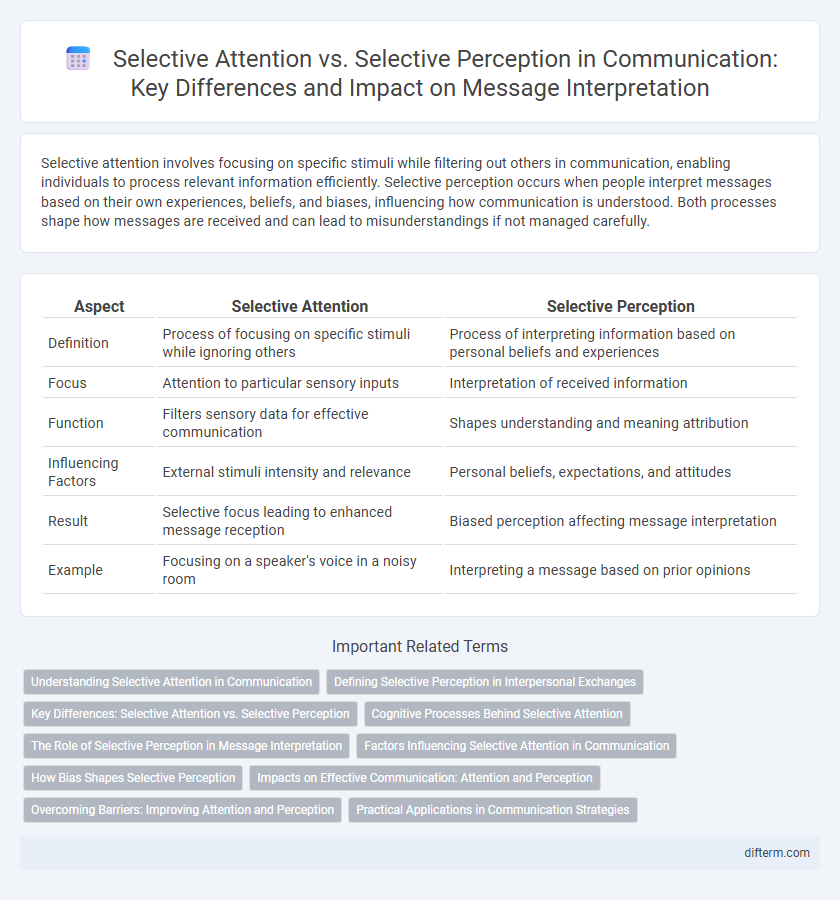Selective attention involves focusing on specific stimuli while filtering out others in communication, enabling individuals to process relevant information efficiently. Selective perception occurs when people interpret messages based on their own experiences, beliefs, and biases, influencing how communication is understood. Both processes shape how messages are received and can lead to misunderstandings if not managed carefully.
Table of Comparison
| Aspect | Selective Attention | Selective Perception |
|---|---|---|
| Definition | Process of focusing on specific stimuli while ignoring others | Process of interpreting information based on personal beliefs and experiences |
| Focus | Attention to particular sensory inputs | Interpretation of received information |
| Function | Filters sensory data for effective communication | Shapes understanding and meaning attribution |
| Influencing Factors | External stimuli intensity and relevance | Personal beliefs, expectations, and attitudes |
| Result | Selective focus leading to enhanced message reception | Biased perception affecting message interpretation |
| Example | Focusing on a speaker's voice in a noisy room | Interpreting a message based on prior opinions |
Understanding Selective Attention in Communication
Selective attention in communication refers to the process by which individuals focus on specific stimuli while ignoring others, enabling efficient information processing amid abundant sensory input. This cognitive mechanism allows people to prioritize relevant messages based on goals, expectations, and contextual cues, enhancing comprehension and response accuracy. Understanding selective attention helps communicators design clearer messages and reduce misunderstandings by aligning content with the audience's focus.
Defining Selective Perception in Interpersonal Exchanges
Selective perception in interpersonal exchanges refers to the process by which individuals interpret and filter messages based on their own beliefs, experiences, and emotions, often leading to biased understanding. This psychological mechanism causes people to notice certain aspects of communication while ignoring others, shaping how messages are received and responded to. Recognizing selective perception is essential for improving clarity and reducing misunderstandings in interpersonal communication.
Key Differences: Selective Attention vs. Selective Perception
Selective attention involves focusing cognitive resources on specific stimuli while ignoring others, directly impacting how information is processed. Selective perception refers to the tendency to interpret information based on individual biases and experiences, shaping subjective understanding. Key differences lie in selective attention's role in filtering sensory input, whereas selective perception influences the interpretation and meaning assigned to that input.
Cognitive Processes Behind Selective Attention
Selective attention is a cognitive process that filters sensory information, enabling individuals to focus on relevant stimuli while ignoring distractions. This mechanism relies on working memory and executive control to prioritize incoming data based on goals and expectations. In contrast, selective perception involves interpreting information based on existing beliefs and biases, influencing how stimuli are perceived rather than filtered.
The Role of Selective Perception in Message Interpretation
Selective perception plays a crucial role in message interpretation by filtering information based on individual biases, beliefs, and experiences, which shapes how messages are understood and internalized. Unlike selective attention, which determines what information is noticed, selective perception influences the meaning assigned to the message content. This process affects communication effectiveness by creating potential discrepancies between the sender's intention and the receiver's interpretation.
Factors Influencing Selective Attention in Communication
Selective attention in communication is primarily influenced by factors such as the intensity and novelty of stimuli, personal relevance, and the individual's current physiological and psychological state. Emotional impact and contrast with surrounding stimuli also play crucial roles in capturing and maintaining attention. Understanding these factors helps optimize message design to ensure effective information processing and engagement.
How Bias Shapes Selective Perception
Selective perception is heavily influenced by cognitive biases such as confirmation bias, which causes individuals to interpret messages in ways that reinforce their existing beliefs and attitudes. This bias shapes the filtering process during communication, leading people to notice only information that aligns with their viewpoints while disregarding contradictory evidence. As a result, selective perception affects how messages are understood, often leading to misunderstandings and communication barriers.
Impacts on Effective Communication: Attention and Perception
Selective attention filters relevant stimuli from the environment, enhancing message clarity and reducing cognitive overload during communication. Selective perception shapes how individuals interpret messages based on their experiences, biases, and expectations, potentially leading to misunderstandings or misinterpretations. Effective communication requires managing both attention and perception processes to ensure accurate reception and interpretation of information.
Overcoming Barriers: Improving Attention and Perception
Selective attention filters critical stimuli amid overwhelming information, while selective perception interprets these stimuli based on prior experiences and biases. Enhancing communication requires strategies such as mindfulness training and environment optimization to sharpen focus and reduce cognitive overload. Implementing feedback loops and active listening techniques further minimizes misinterpretations caused by perceptual filters.
Practical Applications in Communication Strategies
Selective attention enables communicators to filter relevant stimuli, ensuring messages target key audience segments effectively. Selective perception shapes how these audiences interpret messages based on prior beliefs and experiences, requiring tailored framing in communication strategies. Combining both concepts enhances message clarity, engagement, and persuasion in marketing, counseling, and organizational communication.
selective attention vs selective perception Infographic

 difterm.com
difterm.com